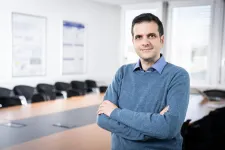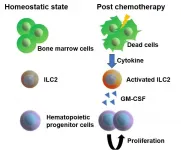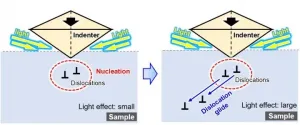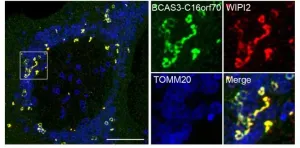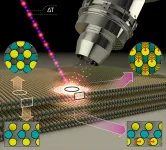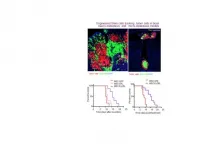INFORMATION:
In addition to PSI, the following institutions are involved in the SCCER Joint Activity "Scenarios and Modelling" collaborative framework: Empa, EPFL, ETH Zurich, Lucerne University of Applied Sciences and Arts, the University of Basel, the University of Geneva, and WSL. The study was financed by Innosuisse - the Swiss Innovation Agency.
Text: Paul Scherrer Institute/Sebastian Jutzi
Contact
Dr. Tom Kober
Head of the Energy Economics Group
Laboratory for Energy Systems Analysis
Paul Scherrer Institute, Forschungsstrasse 111, 5232 Villigen PSI, Switzerland
Telephone: +41 56 310 26 31; e-mail: tom.kober@psi.ch [German, English]
Original publication:
Panos, E.; Kober, T.; Ramachandran, K.; Hirschberg, S. (2021): Long-Term Energy Transformation Pathways - Integrated Scenario Analysis with the Swiss TIMES Energy systems Model; Report of the Joint Activity Scenarios and Modelling of the Swiss Competence Centers for Energy Research. Download pdf version:
https://sccer-jasm.ch/JASMpapers/JASM_results_stem.pdf
Switzerland's energy transition
2021-03-05
(Press-News.org) Can Switzerland, as planned, cut its CO2 emissions to zero by 2050? In a study, researchers at the Paul Scherrer Institute PSI have investigated what measures would be necessary to achieve this reduction and how much it might cost per person.
In August 2019, the Swiss Federal Council decided on an ambitious target to limit climate change: From the year 2050 onward Switzerland should, on balance, discharge no further greenhouse gas emissions. With this commitment, Switzerland meets the internationally agreed goal of limiting global warming to a maximum of 1.5° C compared to the pre-industrial era.
Now a study by the Paul Scherrer Institute, conducted within the Joint Activity "Scenarios and Modelling" of the eight Swiss Competence Centres for Energy Research (SCCER), probes what options for achieving this goal exist in the energy sector.
"The goal of achieving net zero CO2 emissions by 2050 requires drastic transformations in the provision and consumption of energy in nearly all areas," concludes Tom Kober, head of the PSI Energy Economics Group and one of the study's main authors.
In their analyses, the researchers considered energy-related CO2 emissions as well as CO2 emissions from industrial processes. Today these emissions represent around 80% of the entire Swiss greenhouse gas inventory. Not included in the study's calculations are emissions from international aviation, agriculture - with the exception of emissions from fuel combustion - land use, changes in land use, and forestry, as well as waste - except for emissions from waste incineration. Also, emissions in other countries that are associated with consumption of goods in Switzerland were not a subject of the study.
Electricity from photovoltaics must at least double every decade
The central conclusions of the study are: Between now and 2050, the installed capacity of photovoltaic systems must at least double every decade. With 26 terawatt hours of production envisioned in 2050, photovoltaic systems will be the second largest generation technology group behind hydropower (approx. 38 terawatt hours in 2050). Furthermore, power plants with cogeneration of heat and power, as well as wind power plants, hydrogen fuel cells, and electricity imports, all contribute to meeting the demand for electricity. In the main scenario for achieving the net zero emissions target, overall electricity generation from power plants and storage facilities in Switzerland will increase by around one-fifth, to 83 terawatt hours in 2050. The study assumes that Swiss nuclear power plants will be decommissioned by 2045. The private car fleet would have to be largely based on electric motors by 2050, meaning that by 2030 every third new car registered would have to be fully electric. In addition, the use of heat pumps in service and living areas would have to be significantly accelerated, so that by 2050 they could cover almost three-quarters of the demand for heating and hot water. At the same time, it would be necessary to achieve significant energy savings through accelerated renovation of residential buildings.
If Switzerland wants to achieve the net zero emissions target, a significant increase in electricity consumption must be expected. Thus in 2050, electricity consumption might be around 20 terawatt hours above today's level. A fundamental driver of this growth is the use of electricity to power cars, buses, and trucks, either directly in battery-electric vehicles or indirectly through hydrogen or so-called e-fuels - that is, synthetic fuels, which are produced by means of electricity from hydrogen and CO2. In the stationary sectors, the proliferation of installed heat pumps will increase consumption of electricity. If the necessary efficiency gains in heating and hot water supply are achieved, however, these could compensate for the increased electricity consumption. The study results show that stationary sectors could achieve an almost constant level of electricity consumption.
Besides electrical energy, other forms of energy will play a role. For example, long-distance and freight transport as well as energy-intensive industry offer prospects for new hydrogen applications. To produce such low or zero emission hydrogen requires a substantial amount of sustainably generated electricity would be necessary - 9 terawatt hours in 2050.
It probably won't work without CO2 capture
"If Switzerland wants to achieve the zero emissions target by 2050, then in the future CO2 emissions will have to be reduced every year by an average of one to one and a half million tonnes compared to the previous year," says Evangelos Panos, lead author of the study. "We saw changes in CO2 emissions of this magnitude between 1950 and 1980 - albeit in the opposite direction - back then they increased massively." Though it has limitations, CO2 capture was shown to be necessary to implement the emissions reduction cost-effectively. In some subsectors, it might even be possible to reach a negative balance in terms of CO2 emissions. This would be the case, for example, if biomass is used as an energy source and the CO2 produced during energy generation is not emitted, but rather is captured and stored underground. In the event that this should not be possible in Switzerland - for example due to rejection by the population or because of limited sites for CO2 storage - cross-national transport of captured CO2 and storage in other countries could offer aa alternative. In their study the researchers assume, for the year 2050, a total of almost 9 million tonnes of CO2 would be captured in Switzerland.
"More than two-thirds of the emission reductions required for the net zero emissions target can be achieved with technologies that are already commercially available or are in the demonstration phase," Panos explains. The decarbonised energy system of the future is achievable but would require carbon-free energy sources, for example appropriately generated electricity, biofuels and e-fuels, access to the corresponding transport and distribution infrastructures, and the possibility of importing clean fuels and electricity.
Costs are hard to estimate
With regard to costs, the energy system researchers are cautious. "The costs are very difficult to estimate, because an enormous number of components play a role," Kober says. In the net zero main scenario assumed in the study, the average discounted additional costs of the climate protection scenario compared to the reference scenario with moderate climate protection (40% CO2 reduction in 2050 compared to 1990) in Switzerland would amount to around 330 CHF per person per year (basis 2010) for the period up to 2050. Looking at all of the scenarios examined, one can see a range of average costs between 200 and 860 CHF2010 per person per year, which ultimately reflects different developments in energy technologies, resource availability, and market integration, in the acceptance of technologies, and in preferences regarding supply security. The trend in costs shows, above all, a long-term increase, so comparatively high costs can also be expected after 2050.
The study is based on calculations made with the Swiss TIMES Energy System Model (STEM) of PSI, which maps the entire energy system of Switzerland including the various interactions between technologies and sectors. STEM combines a long-term time horizon with high intra-year temporal resolution and calculates, for various future framework assumptions, the cost-minimal configurations of the energy system and the attainment of different energy and climate policy goals. The model was significantly further developed as part of this research project, especially with regard to the options for realising net zero CO2 emissions scenarios. The model is used to calculate scenarios, not to make predictions, but rather give insights into the diverse interactions in the energy system and thus to make a contribution to decision-making support in politics, industry, and society. Specifically, three main scenarios were examined in this study: A reference scenario, a net zero CO2 emissions reduction scenario, and a scenario that assumes the goals of the Swiss Energy Strategy 2050 without explicitly specifying a CO2 reduction target. In addition, seven different variants of the main scenarios were analysed, such as one variant with high technological innovation potential and another variant oriented towards reducing dependence on energy imports.
ELSE PRESS RELEASES FROM THIS DATE:
Species are our livelihoods
2021-03-05
Functioning ecosystems provide the basis for security, basic material needs, health, social interaction and individual liberty. This is how the Millennium Ecosystem Assessment 2005 described it, dividing ecosystem services into the following categories: The provisioning services; goods such as food, water, firewood and timber, the regulating services; pollination, water filtering function of the soil, flood and erosion protection, and the cultural services; recreation, places of inspiration, and education. Many of these services are indirectly and directly linked to the presence of species. For this reason, species conservation is often put forward as a measure for the conservation of vital natural services.
"However, most previous ...
After old age, intellectual disability is greatest risk factor for death from COVID-19
2021-03-05
PHILADELPHIA - Intellectual disability puts individuals at higher risk of dying earlier in life than the general population, for a variety of medical and institutional reasons. A new study from Jefferson Health examined how the COVID-19 pandemic has affected this group, which makes up 1-3% of the US population. The study, published today in the New England Journal of Medicine (NEJM) Catalyst, found that intellectual disability was second only to older age as a risk factor for dying from COVID-19.
"The chances of dying from COVID-19 are higher for those with intellectual disability than they are for people with congestive heart failure, kidney disease or lung disease," says lead author Jonathan Gleason, MD, the James D. and Mary Jo Danella ...
How bone marrow regenerates after chemotherapy
2021-03-05
Osaka, Japan - Chemotherapy has a damaging effect on hematopoietic stem and progenitor cells (HSPCs) in bone marrow. However, once chemotherapy ends, HSPCs regenerate, a process that has remained unknown--until now. In a new study, researchers from Osaka University have identified the molecular mechanism by which HSPCs recover after injury.
HSPCs reside in the bone marrow and give rise to several types of blood cells, such as red blood cells (which carry oxygen), some white blood cells (which are important for the immune system) and platelets (which are necessary to stop bleeding). Because HSPCs constantly divide to generate new cells, they are particularly sensitive to injury induced by, for example, chemotherapy. ...
Light in concert with force reveals how materials become harder when illuminated
2021-03-05
Semiconductor materials play an indispensable role in our modern information-oriented society. For reliable performance of semiconductor devices, these materials need to have superior mechanical properties: they must be strong as well as resistant to fracture, despite being rich in nanoscale structures.
Recently, it has become increasingly clear that the optical environment affects the structural strength of semiconductor materials. The effect can be much more significant than expected, especially in light-sensitive semiconductors, and particularly since due to technological constraints ...
The social support for mothers of patients with eating disorders
2021-03-05
Background: Although caregivers of patients with eating disorders usually experience a heavy caregiving burden, the effects of social support on caregivers of patients with eating disorders are unknown. This study aimed to investigate how social support for mothers who are caregivers of patients with an eating disorder improves the mothers' mental status and, consequently, the symptoms and status of the patients.
Methods: Fifty-seven pairs of participants were recruited from four family self-help groups and one university hospital in Japan. Recruitment was conducted from July 2017 to August 2018. Mothers were ...
BCAS3-C16orf70 complex is a new actor on the mammalian autophagic machinery
2021-03-05
Autophagy is an intracellular degradation process of cytosolic materials and damaged organelles. Researchers at Ubiquitin Project of TMIMS have been studying the molecular mechanism of mitophagy, the selective autophagy process to eliminate damaged mitochondria. PINK1 (a serine/threonine kinase) and Parkin (a ubiquitin ligating enzyme: E3) work together to ubiquitylate the outer membrane proteins of damaged mitochondria, then ubiquitin chains are recognized as signals for autophagy degradation. Dysfunction of mitophagy causes a decrease in mitochondrial quality with overproduction of ROS, and is linked to neurodegenerative diseases like Parkinson's disease.
In Autophagy machinery, cellular components targeted for degradation are engulfed by phosphatidylinositol-3-phosphate (PI3P)-rich ...
Molecular mechanisms identified in chronic skin inflammation
2021-03-05
Frequently occurring chronic skin inflammation like in atopic dermatitis (AD or neurodermatitis) and psoriasis have different causes such as genetic predisposition, stress or allergens. These frequently occurring skin diseases are mostly attributed by biomedical scientists to a disturbed immune system, although the noticeable thickening and flaking of the epidermis, which is the outermost layer of skin, also indicates a disruption of the epithelial cells. A team of researchers from the University Clinic for Dermatology and the Clinical Institute for Laboratory Medicine at MedUni Vienna has now been able to identify new molecular ...
The future of contactless care: robotic systems gain patient approval
2021-03-05
WHO: Giovanni Traverso, MB, BChir, PhD, Associate Physician, Division of Gastroenterology, Brigham and Women's Hospital; corresponding author of a new article published in JAMA Network Open.
Peter Chai, MD, MMS, Assistant Professor, Department of Emergency Medicine, Brigham and Women's Hospital; first author.
WHAT: In the age of COVID-19, mobile robotic telehealth systems could help clinicians and patients interact without contact. Last spring, some health care systems deployed robotic systems within a hospital to evaluate and interact with patients. In a JAMA Network Open article, Traverso and colleagues report the results of a national survey and a cohort study in an emergency department (ED), which analyzed patients' satisfaction with an initial evaluation ...
Instrument at BESSY II shows how light activates MoS2 layers to become catalysts
2021-03-05
MoS2 thin films of superposed alternating layers of molybdenum and sulfur atoms form a two-dimensional semiconducting surface. However, even a surprisingly low-intensity blue light pulse is enough to alter the properties of the surface and make it metallic. This has now been demonstrated by a team at BESSY II.
The exciting thing is that the MoS2 layers in this metallic phase are also particularly active catalytically. They can then be employed, for example, as catalysts for splitting of water into hydrogen and oxygen. As inexpensive catalysts, they could facilitate the production of hydrogen - an energy ...
Engineered 'off the shelf' stem cells target breast cancer that metastasizes to the brain
2021-03-05
Approximately 15-to-30 percent of patients with metastatic breast cancer have brain metastasis (BM), with basal-like breast cancer (BLBC) metastasizing to the brain most frequently. The prognosis for BLBC-BM patients is poor, as the blood-brain barrier prevents most therapeutics from reaching the brain. Testing candidate therapies in clinical trials is also challenging because animal models that mimic BM are limited. In a new study, researchers from Brigham and Women's Hospital and collaborators engineered a bimodal tumor-suppressing and killing molecule that can be delivered to the brain by stem cells. They tested ...
